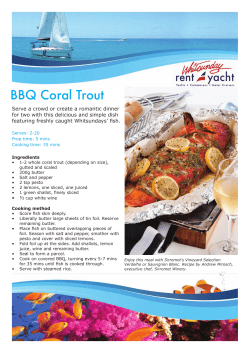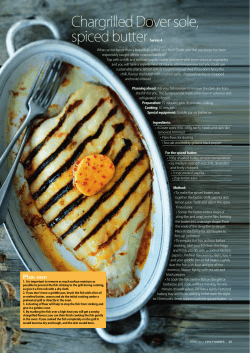
Healthy Seafood Hawaii Seafood and Heart Health Background
Healthy Seafood Hawaii Seafood and Heart Health Background Hawaii is home to Did you know that heart disease is the leading cause of death in Hawaii? In many cases, heart disease can be prevented by eating well and leading an active lifestyle. seafood in the Fish is considered to be a "heart healthy" food because it contains healthy fats and is a rich source of many essential nutrients. Fresh fish is also low in saturated fat and sodium, two nutrients that are known to increase the risk of heart disease when consumed in high amounts. Even though fish is an important food in many Asian and Pacific Island cultures, many people in Hawaii do not eat enough fish. Health Benefits of Fish Fish is the only major source of the long-chain omega-3 fatty acids eicosapentaenoic acid (EPA) and docosahexaenoic acid (DHA) in the human diet. These omega-3 fatty acids are known help prevent and treat heart disease by: Lowering blood triglycerides Helping to prevent arrhythmias (abnormal heart rhythms) Lowering blood pressure Lowering blood cholesterol levels Reducing inflammation Reducing the tendency of blood to clot 6/25/2012 some of the best world! Kapi’olani Community College’s Splash of Aloha cookbook features Hawaii’s finest seafood in over 90 How Much Fish Should I Eat? delicious and heart- The Academy of Nutrition and Dietetics and American Heart Association recommend eating two 4-ounce servings of fish per week. A 4-ounce serving is slightly larger than a deck of playing cards. such as “Broiled Heart Healthy Fish Preparation healthy recipes Opah with Toscano Kale” and “PanRoasted Mahimahi with Ginger-Garlic Shoyu”. Pick up a copy today and eat to your good health. Fish can be prepared and enjoyed in many ways. Consider these tips: Do not overcook or deep fry fish – doing so will decrease the omega-3 content of the fish Moist-heat cooking methods, such as poaching, steaming, and braising help to keep the fish moist and flavorful Add more vegetables to your cooking—carrots, bell peppers, and leafy greens add color and nutrition to your meals Use herbs and seasonings instead of salt or soy sauce to reduce sodium content Ingredients such as lemon juice, garlic, and ginger reduce the need for salt and compliment the flavor of many fish dishes http://www2.hawaii.edu/~cwatters/healthyseafoodhawaii.html Broiled Opah with Toscano Kale (By Chef Kevin Tate) 2 T. butter, divided use Juice of 1/2 lemon 1 T. white wine 1-½ T. garlic powder ½ tsp. salt 1 T. fresh thyme, leaves stripped and chopped fine 1 lb. opah 6-8 c. chopped Toscano kale ½ c. sweet peppers (red, yellow, orange), short julienne 2 T. extra virgin olive oil 1 med red onion, sliced thin ½ tsp. pepper 1) Melt butter in microwave (45seconds at 30%). In a zippered plastic bag, combine melted butter, lemon juice, wine, 1 T. garlic powder, and ¼ tsp. salt and thyme. 2) Cut fish into 4 even pieces and place in a plastic bag with butter-lemon-thyme marinade; marinate 10 minutes. 3) Broil fish 3 minutes (do not turn). Remove from oven and let sit while preparing kale. 4) Place olive oil in a large skillet or wok, heat over medium heat and add onion and peppers and toss to coat with oil. 5) Add kale, remaining garlic powder, salt and pepper. Stir-fry 3 minutes until kale begins to wilt. 6) Add remaining butter. When butter has melted, remove greens to serving plates and top with broiled fish. Makes 4 servings. ~1600 mg EPA+DHA per serving
© Copyright 2025





















